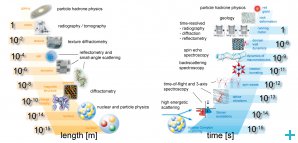Neutron methods and techniques for research
Neutron scattering
Neutron scattering is a means to study the structure, dynamics (movement of atoms) and the compositions of materials.
Just like a beam of light, X-rays or electrons, when a neutron beam interacts with a sample, three possible phenomena can take place: either the neutrons just go through the sample – transmission- or they are captured by the sample – absorption- or their propagation is deviated with respected to the original direction – scattering.
The scattering process can be either elastic (no exchange of energy between neutrons and sample) or inelastic (exchange of energy with the sample): in the first case we speak about diffraction, whereas in the second case we speak about spectroscopy.
Below is a list of neutron methods. You can browse the links on the left for more information about each topic.
Elastic neutron scattering
During elastic neutron scattering, there is no energy loss to or from the the atoms in the sample studied.
The structure of material can be studied using diffraction techniques such as small-angle scattering.
Surfaces and interfaces are analysed by reflectometry and grazing incidence diffraction.
Inelastic neutron scattering
An important characteristic of neutrons is that they can lose or gain energy to or from the atom they bounce against during scattering. This phenomenon, called inelastic scattering will set the atoms in motion, and can therefore reveal their motion patterns.
The most common spectroscopical methods are, in the order of increasing energy resolution: time of flight, backscattering , spin echo and three-axis spectroscopy.
Other methods
Neutron Radiography and Tomography allow imaging that shows information that is quite different from the information X-ray imaging provides.
Precise composition analysis is done by neutron activation analysis .
Particle and nuclear physics use neutrons in several ways – in this field, measurements are done directly at the source or in special setups, not at conventional instruments.

